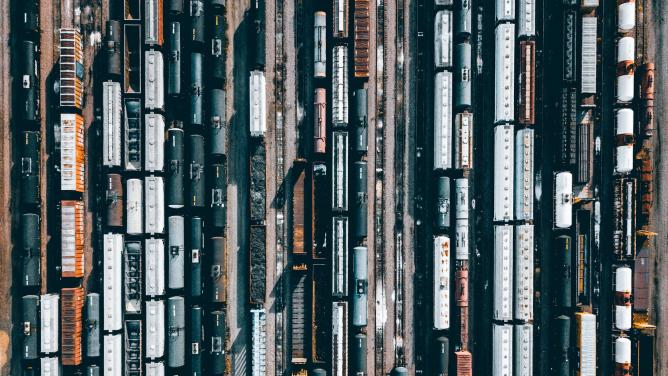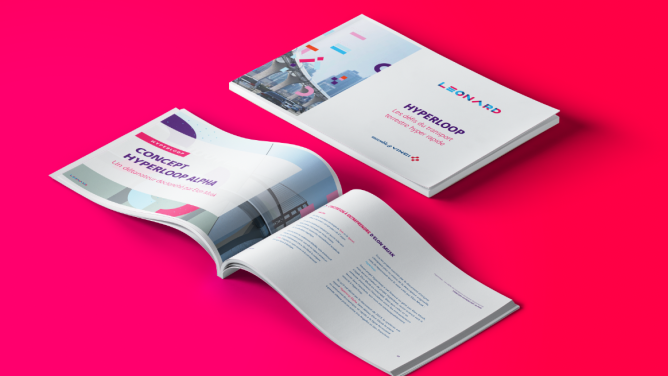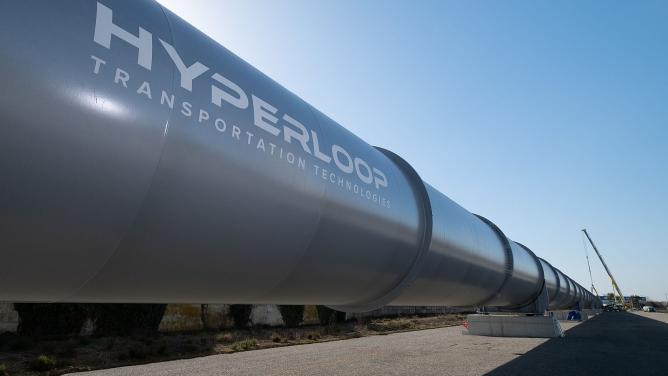TransPod’s capsules are designed to move passengers and goods at over 1,000 km/h from city to city, through a guide tube inspired by the Hyperloop concept. TransPod is currently preparing a demonstrator and working on plans to link Calgary and Edmonton, in Canada.
During his interview with Leonard, Sébastien Gendron took stock of the Hyperloop sector and discussed the impact of the Covid-19 crisis on the high-speed technology market. He also discussed the environmental footprint of tube transport, by comparing the reality of its development with Elon Musk’s initial proposal. More particularly, he shared TransPod’s vision of very high speed’s usefulness today, while also analyzing the financial stakes of the sector.
How has the Hyperloop concept evolved since Elon Musk’s founding paper?
Beyond the 300 km/h train speed, the wheel-rail link begins to pose a problem. Elon Musk, in the “alpha” description of the Hyperloop concept that he published in 2013, made the observation – shared by TransPod – that magnetic levitation (Maglev) technology, that was presented as a credible avenue for very high speed since the 1960s, would be very expensive to implement.
Today, the entire Hyperloop ecosystem has distanced itself from the technical proposals outlined in Musk’s white paper, such as levitation by compressed air. It is a concept paper, not a set of technical specifications. Those who considered it as such spent a lot of money to realize that many of its proposals were not relevant. However, the white paper did open up three fundamental areas: levitation, propulsion, and power transmission. By publishing this paper, Elon Musk did act as a prophet: tube transport gained credibility, but it was also recognized as more complex to achieve than envisaged seven or eight years ago.
How is TransPod positioned?
Our competitive advantage lies in our technology, and more particularly in our high-speed power transmission, which allows us to supply power to the entire vehicle. We transfer the energy through an electric arc (6,000 volts continuous and 700 amps), which works very well in the low-pressure conditions, we are looking for. The patent is now public.
As far as levitation is concerned, we are using electromagnets. This levitation system is located at the top of the vehicle and positions it at about one centimeter from the wall of the tube. As the pod moves, we control the distance between the vehicle and the tube continuously and actively, in real-time.
Concerning propulsion, we chose linear induction motors. These motors are similar to those that already equip certain trains, such as Vancouver’s SkyTrain, that link the airport to the city center. Current developments consist in adapting these motors for very high speed and low-pressure environments. Patents on these specificities are being drafted.
A demonstrator is currently under construction. Our intention is to make it public by this summer.
Are you also planning to offer both freight and passenger services on the same infrastructure?
We have chosen to accommodate both passenger and freight vehicles, so we can improve our economic equation. In Alberta, we are working with DHL and the airports of Calgary and Edmonton. It could be possible to have the same approach in France, by connecting Paris’ airports with the port of Le Havre, for example!
Major logistics operators, that are looking for solutions to decarbonize their road and air-based model, are showing interest in our solution. Tube transport is suitable for all time-sensitive goods: foodstuffs and e-commerce, which has been boosted by the health crisis over the past year. In order to minimize the transfer of goods between different modes of transport, our aim is to use the same containers as those used for air freight.
“Even if it is equipped with high-speed lines, Europe also offers quite interesting prospects!”
What are the targeted markets? How are they chosen?
North America is one of the most promising markets for the Hyperloop concept. The United States has just launched a $2 trillion plan to finance new infrastructure projects! A connection between Toronto, Detroit, and Chicago is under study. Today, we are working with the federal and provincial Canadian governments to establish a corridor between Edmonton and Calgary. We are also evaluating a connection between Toronto and Montreal.
In the Middle East, Saudi Arabia is heavily investing in new technology in order to diversify its economy. The country has launched a feasibility study to assess the possibilities of connecting its two coasts, using the Hyperloop concept.
Even if it is equipped with high-speed lines, Europe also offers quite interesting prospects! Tube transport was mentioned as a credible alternative to air transport and is one of the initiatives identified in the preparatory work for the Green Deal. In France, the links from Le Havre to Paris and from Paris to Toulouse are promising.
What key milestones in the technical development of Hyperloop have been achieved in the past year? What are the next major steps?
At the end of last year, a small vehicle based on Maglev technology reached 1,000 km/h in South Korea. I would like to see France revive the pioneering spirit that enabled Alstom to sell the TGV to Korea in the 1990s!
We need to look closely at what is happening in Europe: a budget will be adopted, and an official mandate given to DG MOVE to regulate tube transport. There are currently four major Hyperloop players on the continent: in the Netherlands, Spain, Switzerland, and Poland. A common certification center could be developed in the Netherlands, with the support of the Dutch government, but this project raises the question of compatibility between very different systems: switches, propulsion modes, levitation, power transmission, etc. How could intelligent synergies be created between them? At a European level, several certification centers with specific expertise could be created.
In the United States, questions remain, as to whether the Biden administration will pursue the creation of the certification center with Virgin Hyperloop in West Virginia, as announced under the previous administration.
How to combine the need for interoperability between Hyperloop systems and the competition between the players in the sector?
There are two approaches on the table. The first approach, being that the infrastructure would be compatible with the different systems, is probably utopian. There is still a lot of development that needs to be done, to know if it will be possible. We should see first what infrastructures will be developed. In the second approach, different installed systems would exist on separate sections. Passengers could change systems or devices during their trip, just like during an air stopover.
“The infrastructure must be sustainable and benefit the energy transition.”
The environmental transition calls for breakthrough solutions in mobility. Will Hyperloop be environmentally virtuous?
Hyperloop is a major infrastructure that runs on electricity, just like high-speed train lines. The environmental impact will therefore depend on the source of the electricity supplied. If this source is mainly hydraulic, like in Quebec, that’s interesting!
Unlike rail, solar panels could be installed on the infrastructure to improve the energy balance. I would remain cautious around this point, as the energy needs of the lines still have to be precisely evaluated to verify if an energy surplus will actually be produced. Though, even if the energy ratio is less than 1, this balance will still be better than the energy balance of a motorway or a railway line.
The carbon impact of the construction of the infrastructure itself must be considered starting the design stage. In France, building our test center in Haute-Vienne has taught us a lot about how to compensate for the environmental impact of the construction.
“We want to build infrastructure that is accessible to all.”
The players are in a race for speed. What is the use of very high speed according to TransPod?
Not all lines will operate at 1 200 km/h! Commercial speed will vary according to the geography of the line, the radii of curvature, the length of the corridor, the search for the optimum energy, etc. Between the 300 kilometers that separate Edmonton and Calgary, the cruising speed will more likely be 700 to 800 km/h.
In addition to speed, there are three other characteristics of existing modes of transport that can be improved. On the one hand, the flexibility of the system: with a vehicle every two minutes, we want to get closer to the frequency of the metro, and thus eliminate the stress that we experience today with traveling by train or plane. The goal is to have on-demand transport for long distances. On the other hand, the price: we want to build infrastructure that is accessible to all. Finally, the infrastructure must be sustainable and benefit the energy transition.
On the 300-kilometer Calgary-Edmonton route, for example, the fare would be 40 to 60 euros for a 40-minute one-way trip. TransPod would be an alternative to a three-hour drive on a dangerous, frequently snow-covered road, and to flying: while the flight is only 30 minutes, Edmonton’s airport is not easily accessible, since it is located 30 kilometers away from the city.
“The challenge now is convincing investors to support a multi-billion financing plan, while the technology is still in development.”
What are the prospects for financing such infrastructure?
We began our project with the observation that 80% of the high-speed lines in the world, or at least in France, are not profitable. The fact is, that the focus is essentially on the train occupancy rate, while the infrastructure occupancy rate is not being dealt with. It would be more interesting to change the economic model, by ensuring that as soon as the line and vehicle development plan are being created, better profitability of the infrastructure is taken into consideration! Which means better optimization of its usage.
The challenge now is convincing investors to support a multi-billion financing plan, while the technology is still in development. The lessons learned in Alberta can be applied to other technologies. Our proposal is to build a first 20-kilometer section to certify the technology and to demonstrate the relevance and viability of high-speed tube transport. In the event that the technology does not achieve certification, we have incorporated into our studies the cost of converting the line to conventional rail infrastructure and recycling the facilities.
“The Covid-19 crisis has had an overall positive impact on our projects.”
What impact did the Covid-19 crisis have on the sector?
The Covid-19 crisis has had an overall positive impact on our projects. Governments have injected a lot of liquidity into the markets and are looking for relevant infrastructure projects to boost the economy. Moreover, the crisis is accelerating the development of innovative solutions to tackle the issue of climate change.
From a financial point of view, all the players who used to invest in so-called conventional infrastructure, considered as low-risk income generators, are starting to realize that in order to diversify their financial investments, they should invest in long-term projects that have interesting market potential and create value.


